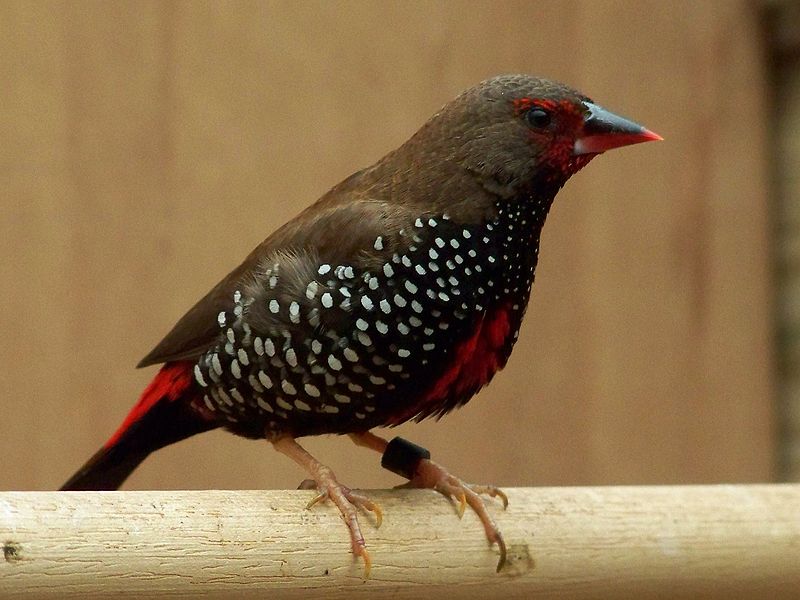Please see Part I of this article for general consideration regarding cage size.
Canaries, Finches, Parakeets and other Small Birds
As mentioned in Part I of this article, the exercise needs of smaller birds are often overlooked…many are quite high strung, and need comparatively more space than do large, calm birds.
A&E Aviary Cages and Double Stacked Bird Cages are true mansions for smaller birds, and the absolute best choice for those that require flying room. The provision of flying space is especially important for birds that do not climb about in the manner of parrots, and for those which cannot be given out-of-the-cage exercise time.
The Blue Ribbon Tall Cage is great for parakeets, lovebirds and other climbers. It can be provisioned with vine and rope perches to increase its usable space and create a very unique effect.
A useful new concept – the second floor – is included in the Blue Ribbon Series 1418 Cage.
The additional height is very much appreciated by shyer finches.
Small Parrots
Cockatiels, lovebirds, conures and other small parrots make use of both flying and climbing space…their ultimate housing option is the A&E Flight/Aviary Bird Cage .
Our Victorian Style Cage opens at the top, allowing your pet access to an open-air perch site. You might also wish to check out our cages for medium-sized birds (please see below).
Medium Parrots
African gray parrots, Goffin’s cockatoos, Amazons and similarly-sized birds are often tricky to accommodate – not quite as large as macaws, they are still hefty and active, and are cramped in typical parrot cages. Our wide selection of Victorian, Dometop and Playtop Cages offer a great many options for all of the most commonly-kept parrots.
Large Parrots and Cockatoos
 A&E Split Level House Cage, which provides ample height, width and length for even the largest avian pets. It also allows for cage-top play areas, an important consideration for large, intelligent birds.
A&E Split Level House Cage, which provides ample height, width and length for even the largest avian pets. It also allows for cage-top play areas, an important consideration for large, intelligent birds.
For something a bit different, consider the A&E Mahogany Cage which is both a fine piece of furniture and a functional, spacious cage.
Shama Thrushes, Pekin Robins, Quail and other Exotics
Cages for less-commonly kept birds must be chosen with careful consideration to the species’ lifestyle- toucans need to hop from branch to branch, white-eyes must have flying room, painted quail require ample floor space – and so on.
Cage size and shape is particularly important for birds which tend to be shy and for those that will not be handled, and thus will spend most of their time confined. Please write in for advice concerning individual species.
Outdoor Aviaries
Our outdoor aviaries are the ultimate in bird homes, allowing your pets the benefits of space, sun and natural light. Ranging from 3.5×4 to 9×5 feet, there is an outdoor aviary for any bird you may keep.
Playpens and Gyms
A larger cage is the most effective means of providing your bird with additional space. You can, however, increase exercise options for tame birds by providing them with one of our unique cage top or free-standing play areas.
Further Reading
Please see my article on Outdoor Aviaries for further information on these ultimate bird environments.

 That Bird Blog – Bird Care and History for Pet Birds
That Bird Blog – Bird Care and History for Pet Birds

 It seems to me that finches are often “short-changed” when it comes to cage space. Their small size, especially when compared to other pet birds, seems to pre-dispose hobbyists to providing equally tiny living quarters. But the facts that a bird “fits” in a cage, and can move about somewhat, does not necessarily mean that we are providing it with an ideal environment.
It seems to me that finches are often “short-changed” when it comes to cage space. Their small size, especially when compared to other pet birds, seems to pre-dispose hobbyists to providing equally tiny living quarters. But the facts that a bird “fits” in a cage, and can move about somewhat, does not necessarily mean that we are providing it with an ideal environment. Then too, many finches tend to be high strung, and are ill at ease when closely confined. It is very hard to hand-tame finches, or to induce breeding in tight quarters. As most finches are not given outside flight time, cage size and complexity are important factors in their husbandry.
Then too, many finches tend to be high strung, and are ill at ease when closely confined. It is very hard to hand-tame finches, or to induce breeding in tight quarters. As most finches are not given outside flight time, cage size and complexity are important factors in their husbandry. A&E Split Level House Cage, which provides ample height, width and length for even the largest avian pets. It also allows for cage-top play areas, an important consideration for large, intelligent birds.
A&E Split Level House Cage, which provides ample height, width and length for even the largest avian pets. It also allows for cage-top play areas, an important consideration for large, intelligent birds.